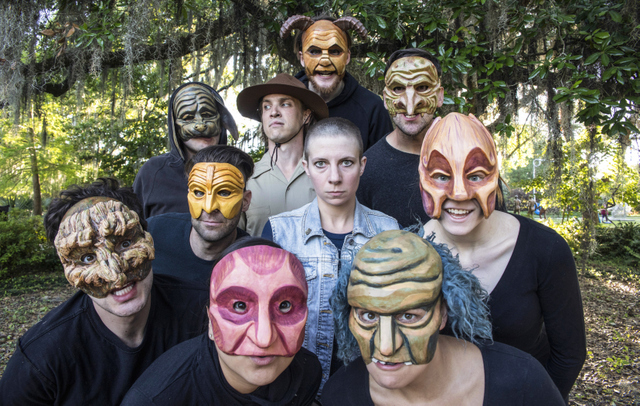
The cast of “The Spider Queen” (Photo by Jeremy Blum)
“THE SPIDER QUEEN”
WHAT: The NOLA Project’s annual collaboration with the New Orleans Museum of Art is a fantasy story and world premiere from members James Bartelle and Alex Martinez Wallace
WHERE: NOMA’s Besthoff Sculpture Garden, City Park
WHEN: 7 p.m. May 10-14, 17-18, 21, 24-26, 28
TICKETS: Adults: $25, NOLA Project Backstage Pass Members: $18, NOMA Members: $18, Students with ID: $18
MORE INFO: http://www.nolaproject.com
We are blessed this week with a double-dose of inspiration at The NOLA Project launches “The Spider Queen” for its annual collaboration with the New Orleans Museum of Art. First, the obvious inspiration: “The Spider Queen, co-written by James Bartelle and Alex Martinez Wallace,” is heavily influenced by “Spider,” the sculpture by Louise Bourgeois that resides in the production’s stage, NOMA’s Besthoff Sculpture Garden. “Spider” tells the story of a teen on a mission to learn how his father died, but winds up going down a rabbit hall along with a tepid park ranger. Along they way they encounter a characters that includes plenty of crazy creatures and, of course, a spider. So we figured Wallace would make for a fun choice to double down on the notion of inspiration by citing some inspirations of his own:

Alex Martinez Wallace
I understand that I’m supposed to remark and embark on a vernacular voyage wherein I divulge with everyone the five cinematic influences that most affected the part I played in writing “The Spider Queen” — but I’m going to break the rules a little bit. And you’re honestly very lucky. Because I could go rule-breaking mad. I could have just sent to the editor-in-chief a painting of my influences. Or just a dreadful pencil drawing or some other such thing they absolutely didn’t ask for (mud slung fitfully against a blank wooden door), which, while it might mean something truthful and genuine to me, gives the kind readers of this editorial virtually nothing to go on.
I’ve lived non-sequiturally before. Sometimes I like getting yelled at. James Bartelle, with whom I co-wrote this story, was very good about keeping things from getting absolutely Loony Tunes while simultaneously letting me stretch my big dumb feathery wings. So I’m only going to break the rules a little here. And so most of my influences aren’t films. Some are television shows, and one is a play. I’m actually being really well behaved. A good boy! Arguably.
5) “THE LORD OF THE RINGS: THE FELLOWSHIP OF THE RING” (BOTH THE MOVIE AND THE BOOK) — Particularly the first installment of the trilogy, because it, more than the other two, asks you to swallow the most nonsense right out the gate. If you aren’t willing right away to eat the history of the One Ring, and the thousands of elves and dwarves and men and the great war that was many thousands of years ago and has now come thundering back into the present with the rediscovery of the ominous golden circlet and another imaginary race of tiny Hobbits … then the rest of the movie will sit with you as well as a hot-shit sandwich. You really just gotta go with it. It’s like the smash hit film “Inception.” If you start asking too many questions, you’re gonna miss something and then, before you know it, the main character of the play is in Gardendale talking to a flower person and you won’t know why. Just go with it. And “The Spider Queen” plunges you headlong right into the Council of Elrond. No foreplay! In theater, we can’t have lengthy voiceovers with historical cut scenes, or a length of text scrolling into the stars that sets the tone of the show. Well, we could, but it’s a lazy-bum solution. And we don’t have tiiimmme. There’s a kingdom in peril and two worlds colliding, and if you want in, you’ll have to hold on to your butts and jump in headfirst. And, like in Middle Earth, singing a song or poetry recital is a perfectly acceptable way to respond to any situation. That was particularly true in the books. “Why is Tom Bombadil singing? Again? Why, God, why?” Go with it — this isn’t your world — you aren’t in Kansas anymore. If you can’t tell by now, I’m a geek by many measures; if you’ve any experience with fantasy stories of any kind, you’ll slip into this play as easily as a familiar old worn leather boot
4) “STRANGER THINGS” — The first and largest revision of the play happened right when Netflix released “Stranger Things” — and just in time, too. The first cut of the play was going in a very odd direction. Very 1980s … but like… too 1980s. Like each character had their own hairband rock song. It’s ironic that a show set so completely in the ’80s helped move our play out of the ’80s. But more than anything, “Stranger Things” helped us conceptualize a fantasy world whose features were a reflection of our own world as opposed to a fantasy world with its own random lineaments. It also helped us, we hope, create a multifaceted heroine who takes the audience on a journey unlike any that has been seen onstage before. We also incorporated Eggo Waffles into the play — lololol that’s a lie. Continue reading





